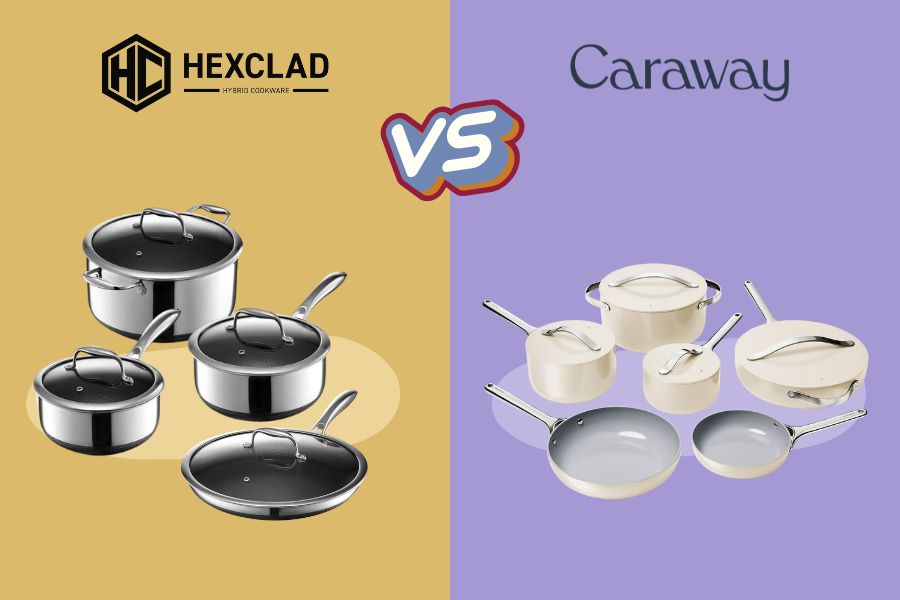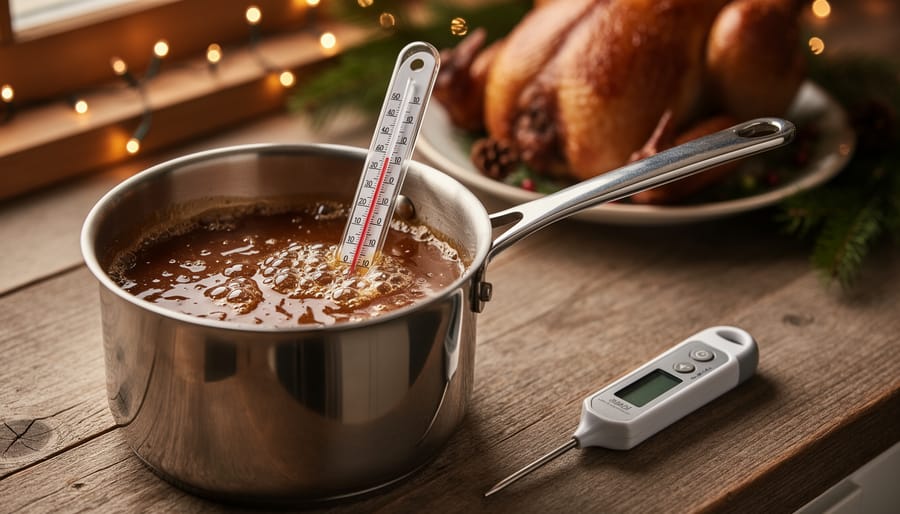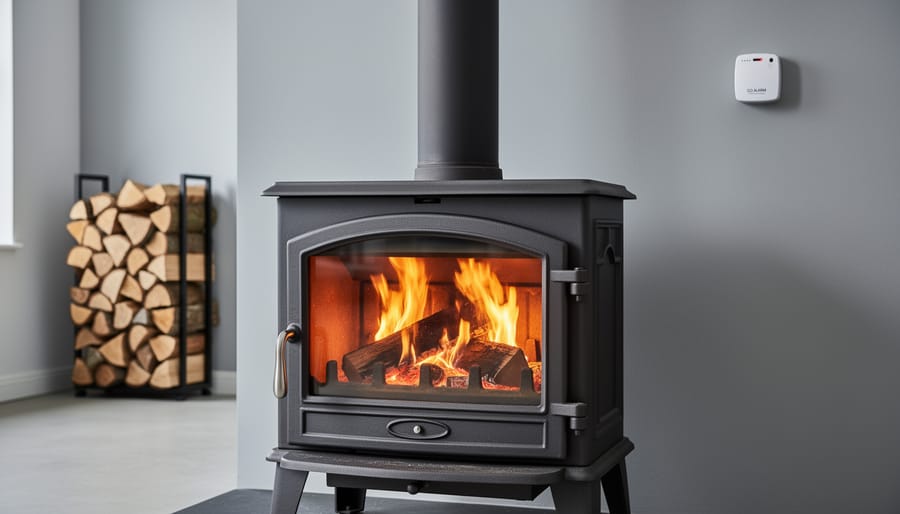Hey there! Newell here again. I’ve spent countless hours in the kitchen, knowing the right cookware can make all the difference. That’s why I’m diving into a detailed comparison of two popular cookware brands: Hexclad and Caraway.
We’ll explore their features, talk about what sets them apart, and ultimately, help you decide which one might better fit your cooking needs.
As someone who values freedom in the kitchen, I know the importance of having cookware that adapts to your style. So, stick around whether you’re a seasoned chef or just starting. This is going to be a tasty ride!
Key Takeaways
- HexClad cookware is pricier than Caraway but justifies the higher price with exceptional quality and performance.
- HexClad and Caraway offer non-stick and scratch-resistant cookware with even heat distribution.
- HexClad and Caraway cookware are PFOA-free and PTFE-free, oven-safe, and compatible with all stovetops.
- HexClad offers more options for cookware sets, individual pieces, and customization, while Caraway offers a full set with limited customization options.
Overview of Hexclad
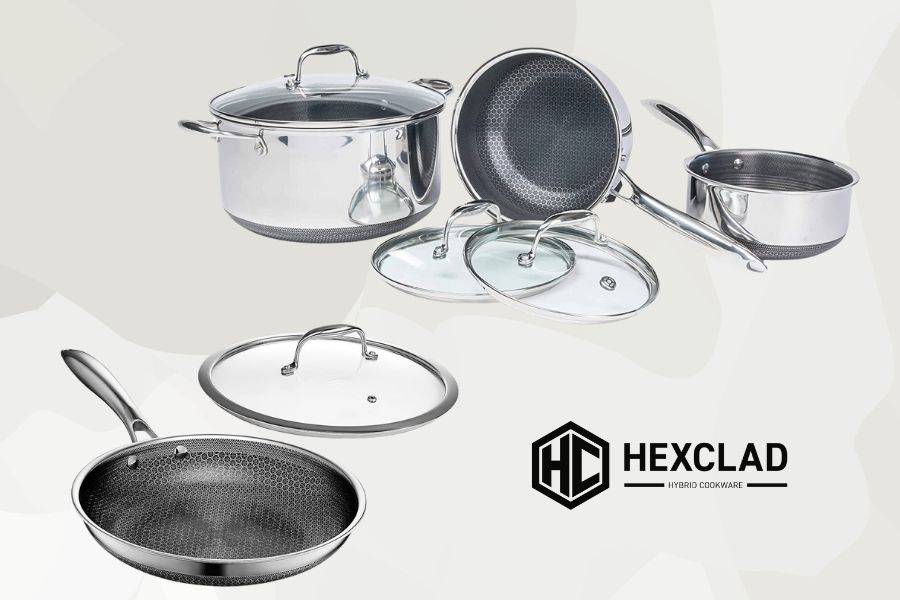
HexClad’s nifty hybrid cookware marries the hardiness of stainless steel with the non-stick convenience of a Teflon pan. It feels like you’re cooking on a resilient cloud built to weather any culinary storm.
The brand’s innovative design uniquely balances durability and ease of use. With its tri-ply construction, involving an aluminum core sandwiched between two layers of stainless steel, HexClad ensures optimal heat distribution, making your cooking experience more efficient.
The brand reputation stands strong, owing to its steadfast commitment to quality. The HexClad range, with its robustness and non-stick surface, liberates you from the usual cooking constraints. It allows you to experiment and enjoy your time in the kitchen, embodying the best of both worlds.
Pros:
- Made with a hybrid coating of stainless steel and ceramic, which is more durable than traditional nonstick coatings.
- Dishwasher safe.
- Oven safe up to 500 degrees Fahrenheit.
- Induction compatible.
- Lifetime warranty.
Cons:
- More expensive than some other nonstick cookware brands.
- The stainless steel base can be reactive with acidic foods.
Overview of Caraway
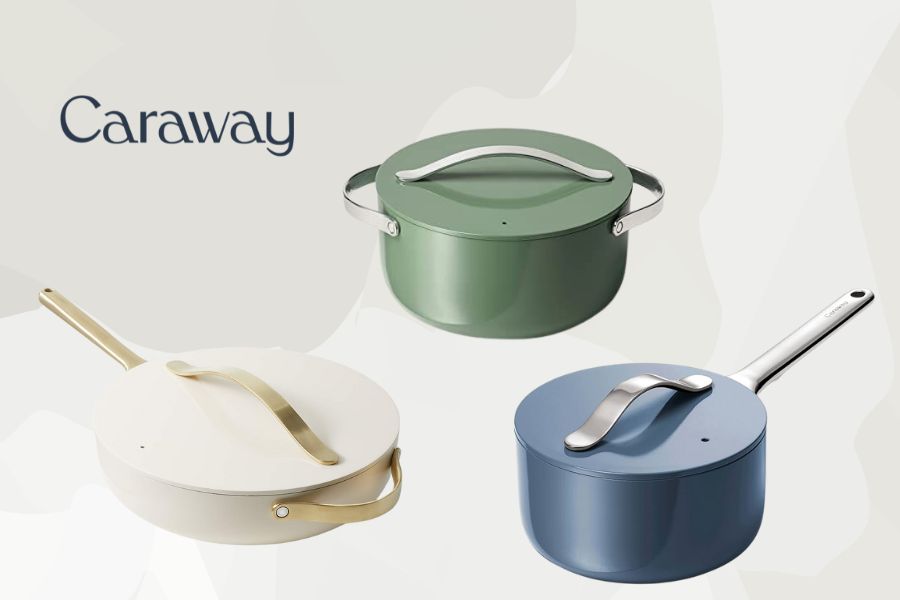
Caraway’s ceramic-coated collection offers nonstick cookware that is both stylish and safe. It is a perfect blend of elegance and functionality. The design is pleasing to the eye and offers practical features for easy cooking.
The materials used in its construction are durable and free of harmful chemicals, ensuring pure and healthy meals. The ceramic coating is heat-resistant and can endure up to 500 degrees Fahrenheit.
Customers rave about its ease of use, easy to clean, and the peace of mind it provides, knowing that they’re cooking with non-toxic materials. Caraway offers freedom from worry.
Pros:
- Made with ceramic coating, which is free of toxic chemicals and PFOA.
- Dishwasher safe.
- Oven safe up to 500 degrees Fahrenheit.
- Induction compatible.
- Lifetime warranty.
Cons:
- The ceramic coating can be scratched if not properly cared for.
Caraway vs Hexclad [In-depth Comparison]
We will focus on several key factors as we delve deeper into the comparison between Caraway and Hexclad. These factors include their construction, design, durability, heat distribution, and scratch resistance. This discussion aims to provide an informative and detailed analysis of both products, giving insight into their pros and cons.
Before we get started, let’s have a look at the comparison table first:
| Feature | Caraway | Hexclad |
|---|---|---|
| Coating | Ceramic | Stainless steel + ceramic |
| Non-toxic | Yes | Yes |
| PFOA-free | Yes | Yes |
| Dishwasher safe | Yes | Yes |
| Oven safe | Up to 500°F | Up to 500°F |
| Induction compatible | Yes | Yes |
| Lifetime warranty | Yes | Yes |
| Price | $$ | $$$ |
| Durability | Good | Excellent |
| Scratch resistance | Good | Excellent |
| Heat distribution | Good | Excellent |
| Reactive with acidic foods | No | Yes (to a slight degree) |
So, let’s set the stage for an in-depth look at these two popular cookware brands.
Construction
While Caraway’s simplistic design involves a single layer of ceramic coating bonded to aluminum, HexClad boasts a robust tri-ply construction combining aluminum and stainless steel, offering superior durability at a steeper price point. In this comparison, it’s clear that both brands’ construction has pros and cons.
Caraway’s ceramic coating provides a non-stick surface but is more delicate. Metal utensils can scratch and damage it, so you’re limited to silicone or wooden tools.
HexClad’s tri-ply construction enhances performance with its excellent heat conduction and durability. However, this durability comes with a higher price tag.
The construction of HexClad also makes it suitable for cooking without food sticking, a convenience that can be appreciated.
So, it’s a toss-up between durability and price, delicate yet affordable, or robust and costly.
Design
In terms of aesthetics, you’ve got the minimalist charm of Caraway’s understated elegance and the modern sleekness of HexClad’s innovative design.
Reading through reviews, Caraway’s single-layer ceramic coating and wooden-accented handles resonate with users who prefer simplicity and safety in their cooking surfaces. It’s a popular choice for those who value functionality through simplicity.
On the flip side, the HexClad line turns heads with its unique hexagonal pattern and tri-ply construction. User experiences reveal a preference for its textured look and silicone-gripped handles. HexClad’s design is a frontrunner for those seeking a more modern and bold cooking experience.
Both offer freedom in their own way, catering to different aesthetics and needs.
Durability
Moving from the aesthetic attributes, let’s dive into the crucial durability aspect. HexClad takes the lead in this regard due to its tri-ply construction. This advanced build enhances its durability and boosts nonstick capabilities and induction compatibility.
The scratch resistance of HexClad is impressive. You can freely use metal utensils without worrying about inflicting damage, allowing you to cook without restrictions.
Caraway, though durable, might not withstand metal utensils or accidental drops as HexClad does.
HexClad’s warranty is a testament to its durability, assuring long-term use.
Caraway requires more careful handling, but with proper care, it promises longevity.
In the face of durability, HexClad seems a more resilient companion, safeguarding your culinary adventures.
Heat Distribution
You’ll find that the evenness of heat distribution can be a game-changer in your cooking experience, taking you from patchy pancakes to perfectly golden ones. When comparing HexClad and Caraway, it’s important to consider the heat distribution quality.
While Caraway cookware offers good heat distribution with its single layer of ceramic coating bonded to an aluminum sheet, HexClad stands out in this area. The tri-ply construction, consisting of an aluminum core sandwiched between two layers of stainless steel, allows for superior heat conduction. This means your cooking results will be more consistent with HexClad.
Despite its higher prices, the best and most affordable choice for even heat distribution and freedom in cooking might well be HexClad.
Scratch Resistance
Regarding scratch resistance, your metal utensils won’t be a problem using the durable nonstick HexClad cookware. The nonstick coating on HexClad is robust and protected by a tri-ply stainless steel construction, making it resistant to scratches and perfect for those who value freedom in their cooking style.
On the other hand, the ceramic Caraway option might require a bit more care to keep it looking and performing its best. Caraway’s ceramic coating, while scratch-resistant, is more delicate and needs careful handling, particularly during cleaning.
However, this eco-friendly and best cookware offers excellent durability when treated right, promising years of use.
While both offer scratch resistance, HexClad provides a more forgiving experience, and Caraway demands a gentler touch.
Dishwasher and Oven Safety
Imagine the relief of knowing your cherished cookware is safe from scratches and ready to withstand the heat of your oven and the convenience of your dishwasher. This is where Caraway and HexClad cookware come in.
Caraway cookware is safe to use in the dishwasher, but only on the top rack. It’s protected with a delicate ceramic coating that could be damaged if placed on the bottom rack, where it could be exposed to sharp objects or high-pressure water jets.
On the other hand, HexClad is dishwasher-safe and oven-safe up to 500 degrees Fahrenheit. You can sear meat in the oven and pop it straight into the dishwasher without fear.
Now, that’s what I call freedom!
Induction Compatibility
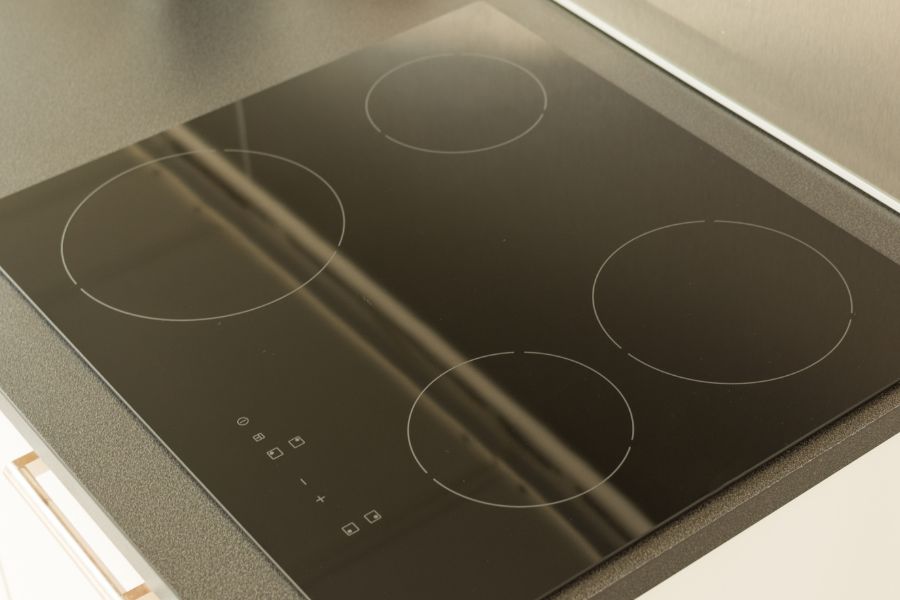
Rest assured, both your cherished cookware sets are fully induction compatible. They are designed to work flawlessly with all induction cooktops, adding to your convenience and cooking versatility.
The Caraway and HexClad cookware, owing to their ferromagnetic bottoms, work seamlessly with induction cooktops. This ensures that you can use them as per your culinary needs.
The manufacturers of both cookware product lines have confirmed their compatibility, giving you peace of mind and a clear green signal to cook up a storm.
So, whether you own a Caraway cookware set or a HexClad one, you’re all set to enjoy cooking on your induction cooktop. Their compatibility opens up a world of possibilities for you, letting you explore various cooking methods and adding flexibility to your kitchen setup.
Warranty
Transitioning from induction compatibility, let’s delve into another essential aspect – warranties.
If you’re like me, you want a solid guarantee for your investment. So, let’s compare Caraway and HexClad’s warranty policies.
Caraway offers a one-year warranty that covers any defects in materials or workmanship. If something goes awry within the first year, they’ll repair or replace it, no questions asked.
On the other hand, HexClad steps it up a notch with a lifetime warranty. That’s right, a lifetime. This warranty, too, covers material and workmanship defects. So, if anything happens to your HexClad cookware at any point in time, they’ll fix or replace it for free.
This offers a remarkable assurance of freedom from worries about durability.
Price Comparison
Now, let’s discuss the price point of these two brands and consider the quality and durability they offer.
It’s no secret that Hexclad is pricier than Caraway. It’s positioned to compete with high-end, premium cookware brands specializing in chef-grade stainless-steel cookware.
With Caraway, you can expect a full cookware set for under $600.
Hexclad, on the other hand, demands a heftier investment. You’re looking at a price tag of around $800 to $1,000 for a comparable set.
But remember, you’re paying for the exceptional quality, durability, and performance of Hexclad. It’s a significant investment, but it might be worth the extra cost for those who value their freedom in the kitchen.
FAQs:
Are Hex Clad Pans Worth It?
Whether or not HexClad pans are worth the investment depends on your individual needs and budget. If you are looking for a high-quality set of cookware that will last for years, then HexClad pans are a good option. However, if you are on a tight budget, other less expensive options are available.
How Long Do Hex Clad Pans Last?
HexClad pans are built to last. With proper care, they should last for many years. However, the exact lifespan of a HexClad pan will vary depending on how often it is used and how well it is cared for.
Are Caraway Pans Healthy?
Caraway pans are made with a mineral-based, non-stick coating that is free of PTFE, PFOA, and other harmful chemicals. This makes them a healthy choice for cooking.
Can You Use Caraway Pans on High Heat?
Yes, you can use Caraway pans on high heat. However, it is important to note that the non-stick coating may start to break down if the pans are heated too high. It is best to use medium-high heat when cooking with Caraway pans.
Conclusion – Which One Is Better?
In the end, both Hexclad and Caraway have their strengths.
Hexclad’s hybrid design gives it an edge in durability and versatility.
Caraway’s non-toxic, eco-friendly approach is quite appealing.
The choice ultimately depends on your personal cooking needs and preferences.
Whichever you choose, both brands promise to deliver high-quality cookware that can transform your kitchen experience.
Also, Read:

